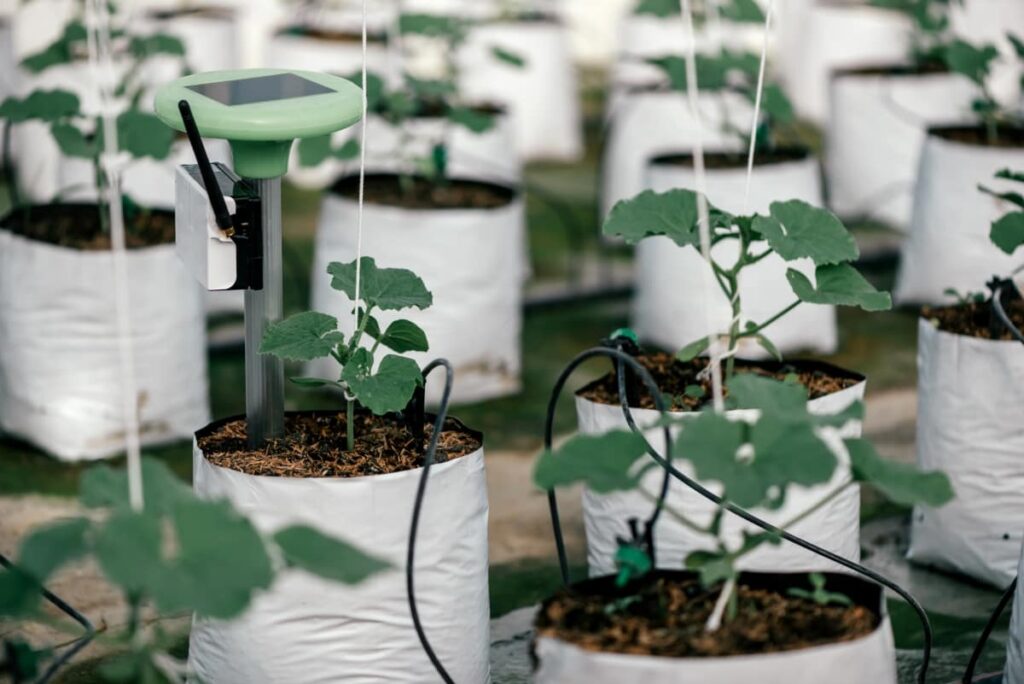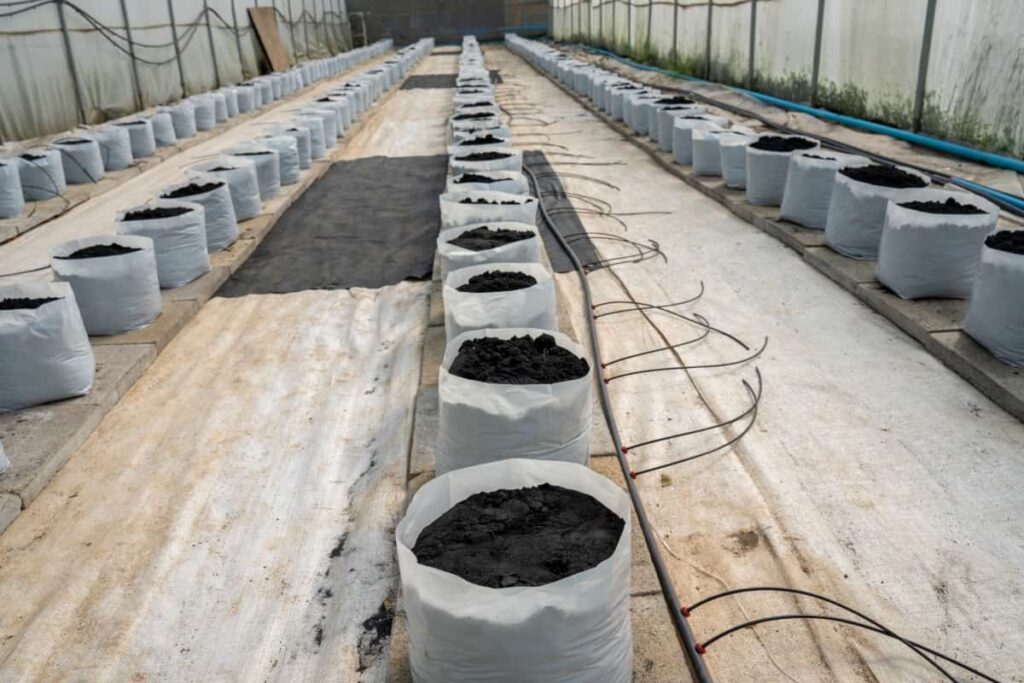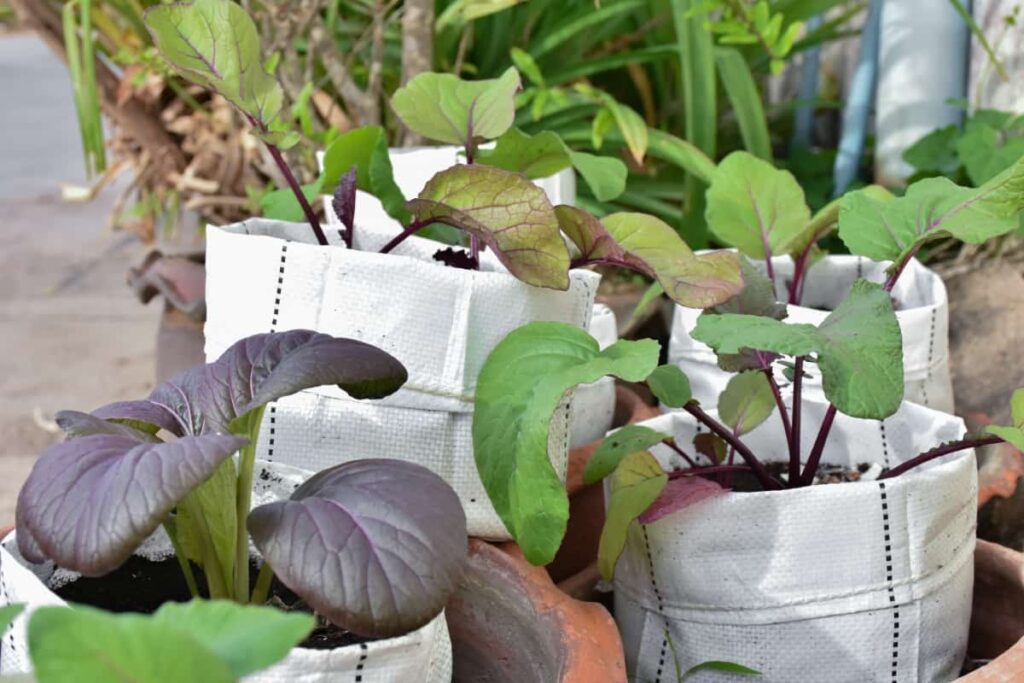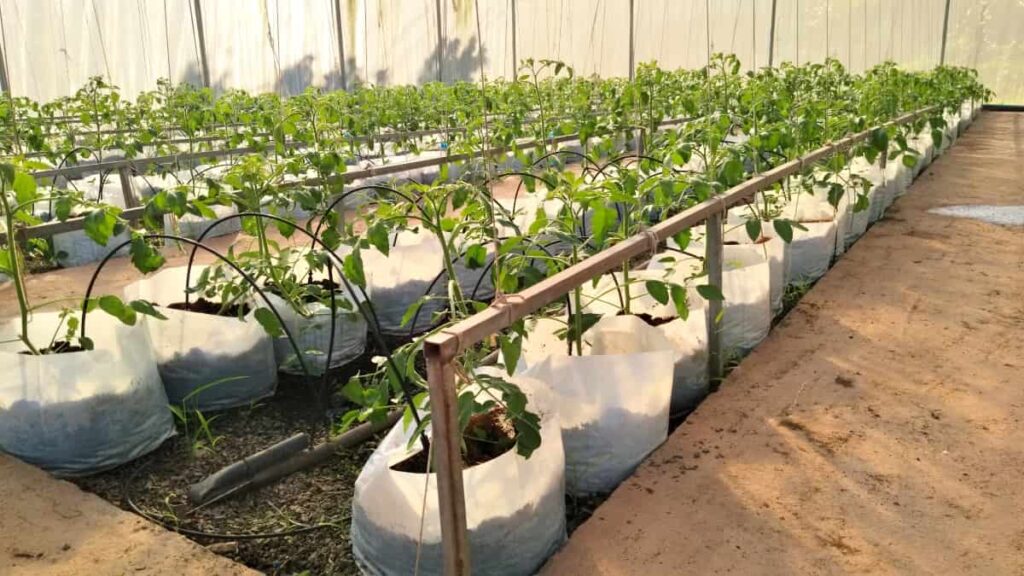Grow bag gardening is similar to the container gardening method of cultivating plants in bags made of various materials such as fabric or plastic. This grow bag gardening approach is particularly popular among urban gardeners due to its space-saving nature and high yield potential.
Overview of Grow Bag Gardening
Grow bag gardening is a versatile and space-efficient method of cultivation, ideal for urban gardeners limited by space constraints. Grow bag farming involves growing plants in bags filled with soil or compost. Grow bags offer a convenient and efficient way to grow plants in constrained spaces, like balconies, patios, or rooftops. They provide excellent aeration and drainage for plant roots, resulting in healthier growth compared to traditional containers.
Benefits of Using Grow Bags: Advantages of Grow Bag Gardening
- Space Efficiency: Ideal for small spaces like balconies, patios, or rooftops.
- Portable Gardening Solutions: Easy to move around to optimize sunlight exposure.
- Better Drainage: Prevents waterlogging and promotes healthier root growth.
- Weed Control: Reduces the risk of weeds compared to traditional soil beds.

Grow Bag Cultivation for Urban Gardeners
Types of Grow Bags
Fabric Grow Bags
- Fabric grow bags can made from breathable fabric like felt or canvas, which is suitable for organic grow bag farming.
- Allows air to penetrate, promoting root health.
- Prevents overwatering and root circling.
- Fabric grow bags promote better aeration and drainage, preventing root rot.
- Durable and reusable, withstanding multiple growing seasons.
Plastic Grow Bags
- Made from sturdy plastic materials like polyethylene or similar materials.
- Lightweight and easy to transport.
- Generally less breathable than fabric bags.
- Retain moisture well, suitable for plants with higher water requirements.
- Affordable and readily available, but may require drainage holes.
DIY Grow Bags
- These can be made from recycled materials like old fabric, burlap sacks, or plastic containers.
- These DIY grow bag ideas are cost-effective and customizable to suit individual gardening needs.
- Also, these DIY grow bag ideas are environmentally friendly and reduce waste.
Choosing the Right Grow Bags
Size and Volume Considerations
- Select bags based on the space available and the plant’s mature size for urban gardening with grow bags.
- Larger bags provide more room for root development and accommodate larger plants.
- Smaller bags may be suitable for herbs, lettuce, or small vegetables.
- Consider the volume of soil needed for optimal growth and moisture retention.
Material Properties and Plant Health
- Fabric bags are preferred for their breathable nature and root health benefits.
- Plastic bags are suitable for moisture-loving plants but may require additional drainage.
- Ensure bags are free from harmful chemicals to avoid contaminating the soil and plants and sustainable grow bag cultivation.
Preparing Your Grow Bags for Planting
Soil and Compost Mixtures
- Use a well-draining, nutrient-rich soil mix for grow bags for optimal plant growth.
- Blend compost, perlite, and organic matter to improve soil structure and fertility.
- Fill bags to the appropriate level, leaving room for watering and root expansion.
Preparing and Positioning the Bags
- Place grow bags in a sunny location with at least 6-8 hours of sunlight daily.
- Arrange bags to maximize space and airflow between plants.
- Ensure bags are stable and won’t tip over, especially in windy conditions.
In case you missed it: Hydroponics in Urban Apartment Gardening: Benefits and How to Set Up Guide

Selecting Plants for Grow Bag Cultivation
Best Vegetables for Grow Bags
- Tomatoes: As one of the best vegetables for grow bags, Dwarf or determinate varieties work well in grow bags.
- Peppers: Bell peppers, chili peppers, and other varieties thrive in containers.
- Salad greens: Lettuce, spinach, and arugula can be harvested as baby greens.
- Root vegetables: Carrots, radishes, and beets can be grown in deeper bags.
- While choosing the best vegetables for grow bags, Avoid sprawling or vining plants that may outgrow the bags or require trellising.
Flower and Herb Varieties Suitable for Grow Bags
- Herbs like basil, cilantro, and parsley thrive in grow bags, providing fresh flavors for culinary use.
- Flowers such as marigolds, petunias, and pansies add color and beauty to urban spaces.
- Select varieties that tolerate container growing and adapt well to limited root space.
Planting Techniques in Grow Bags
Seed Sowing and Transplanting
- Start seeds indoors or purchase seedlings for transplanting into grow bags.
- Carefully loosen the root ball before planting to encourage proper root growth.
- Water newly transplanted seedlings gently to reduce transplant shock.
Spacing and Depth Guidelines
- Follow the recommended spacing guidelines provided on seed packets or plant tags.
- Plant seeds or seedlings at the seed package label-guided depth to ensure adequate root development.
- Avoid overcrowding to avoid competition for nutrients and airflow.
Irrigation and Water Management in Grow Bag Farming
Watering Requirements for Grow Bag Plants
- Regularly monitor soil moisture and water as needed to keep the soil evenly moist.
- Overwatering should be avoided, which leads to root rot, and underwatering, which stunts plant growth.
- Water early in the morning to minimize evaporation loss.
Tips for Efficient Water Use
- Apply mulch around the plant base to retain moisture and reduce water runoff.
- As watering techniques for grow bags, use drip irrigation systems or watering wands to deliver water directly to the root zone.
- Install saucers or trays beneath grow bags to catch excess water and prevent staining surfaces.
Nutrition and Fertilization Strategies
Organic and Inorganic Fertilizers
- Choose fertilizers suited to the specific needs of your plants, whether organic or synthetic, for fertilizing grow bag plants.
- Organic options include compost, fish emulsion, and seaweed extracts for slow-release nutrients.
- Synthetic fertilizers provide readily available nutrients but may require more frequent applications.
Feeding Schedules for Optimal Growth
- Follow a regular fertilization schedule based on plant growth stages and nutrient requirements.
- Start with a balanced fertilizer during the early growth phase and adjust ratios as needed.
- Avoid over-fertilization, which leads to nutrient imbalances and plant stress.
In case you missed it: Urban Gardening Ideas for Beginners: Tips, Tricks, and Techniques

Pest and Disease Management
Common Pests in Grow Bag Gardening
- Keep an eye out for common pests such as aphids, whiteflies, and caterpillars for pest management in grow bags.
- Inspect plants regularly for signs of damage, including holes in leaves or wilting foliage.
- Use physical barriers like row covers or companion planting to deter pests naturally.
Preventive Measures and Organic Controls
- Practice good sanitation by removing debris and fallen leaves to reduce pest habitat.
- Introduce beneficial insects like wasps, ladybugs, or predatory mites to control pest populations.
- Use organic pesticides like DE, neem oil, insecticidal soap, or else prepare homemade remedies.
Harvesting and Post-Harvest Care
Signs of Maturity and Harvesting Techniques
- Harvest vegetables and herbs when they reach peak ripeness and flavor.
- Use a sharp knife to avoid damaging plants during harvesting.
- Continuously harvest crops to encourage new growth and prolong the harvest season.
Cleaning and Storing Grow Bags for Future Use
- Empty reusable grow bags of soil and debris after harvesting.
- Clean fabric bags by hand washing with mild soap and water, then air drying thoroughly.
- Store bags in a dry place to prevent mold or mildew growth between uses.
In case you missed it: A Guide to Understand Vertical Urban Farming/Gardening: Check How this Helps Beginners

Conclusion
By following this grow bag setup guide, choosing the right grow bags, selecting suitable plants, and implementing proper grow bag plant care techniques, even the smallest urban spaces can become thriving gardens bursting with life and color. With careful planning and attention to detail, urban gardeners can enjoy the rewards of grow bag gardening year-round, bringing fresh, homegrown produce and beauty to their urban oasis.
- Aquaponic Farming at Home: A Step-By-Step Guide
- Profitable Village Farming Business Ideas in 2024
- High-Yield Aquaculture: Fast-Growing Fish for Farming
- Effective Fish Pond Construction Techniques for Beginners
- Irrigation and Water Management in Pineapple Farming
- Blossom to Harvest: Mastering Flowering and Pollination in Papaya Farming
- Pig Fattening Essentials: From Selection to Sale for Beginners
- Raising Wagyu Cattle: A Complete Guide for Premium Beef Production
- Soil Types and Their Water Holding Capacity
